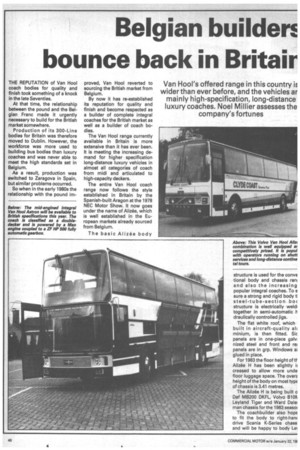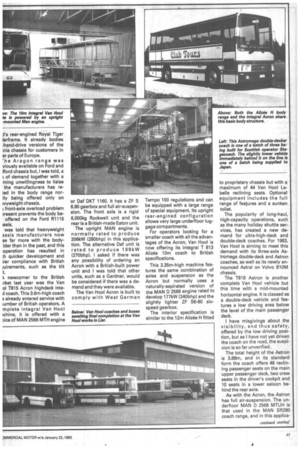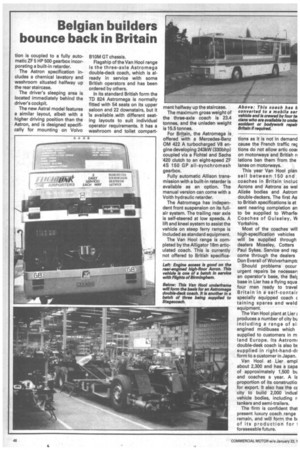Belgian builder bounce back in Britair
Page 48

Page 49

Page 50

If you've noticed an error in this article please click here to report it so we can fix it.
Van Hool's offered range in this country iE wider than ever before, and the vehicles ar mainly high-specification, long-distance luxury coaches. Noel Millier assesses the company's fortunes
THE REPUTATION of Van Hool coach bodies for quality and finish took something of a knock in the late Seventies.
At that time, the relationship between the pound and the Belgian Franc made it urgently necessary to build for the British market somewhere.
Production of its 300-Line bodies for Britain was therefore moved to Dublin. However, the workforce was more used to building bus bodies than luxury coaches and was never able to meet the high standards set in Belgium.
As a result, production was switched to Zaragova in Spain, but similar problems occurred.
So when in the early 1980s the relationship with the pound im proved, Van Hool reverted to sourcing the British market from Belgium.
By now it has re-established its reputation for quality and finish and become respected as a builder of complete integral coaches for the British market as well as a builder of coach bodies.
The Van Hool range currently available in Britain is more extensive than it has ever been. It is meeting the increasing demand for higher specification long-distance luxury vehicles in almost all categories of coach from midi and articulated to high-capacity deckers.
The entire Van Hool coach range now follows the style established in Britain by the Spanish-built Aragon at the 1978 NEC Motor Show. It now goes under the name of Alizee, which is well established in the European markets already sourced from Belgium.
The basic Alizee body structure is used for the conve .tional body and chassis rani and also the increasing popular integral coaches. To e sure a strong and rigid body tl steel-tube-section boe structure is electrically weld together in semi-automatic h draulically controlled jigs.
The flat white roof, which built in aircraft-quality aui minium, is then fitted. Sic panels are in one-piece galv nized steel and front and rei panels are in grp. Windows al glued in place.
For 1983 the floor height of tf Alizee H has been slightly ii creased to allow more unde floor luggage space. The overt. height of the body on most type of chassis is 3.41 metres.
The Alizee H is being built c Daf MB200 DKFL, Volvo B1011 Leyland Tiger and Ward Dale: man chassis for the 1983 seasoi The coachbuilder also hopE to fit the body to right-hanc drive Scania K-Series chass and will be happy to body Lel J's rear-engined Royal Tiger lerframe. It already bodies -hand-drive versions of the nia chassis for customers in er parts of Europe.
he Aragon range was viously available on Ford and fiord chassis but, I was told, a c of demand together with a ming unwillingness to liaise the manufacturers has reted in the body range norIly being offered only on ivyweight chassis.
I front-axle overload problem wesent prevents the body beoffered on the Ford R1115 iss is.
was told that heavyweight assis manufacturers now se far more with the body'der than in the past, and this operation has resulted in :h quicker development and ;ier compliance with British luirements, such as the tilt t.
k newcomer to the British irket last year was the Van ol T815 Acron highdeck inteil coach. This 3.6m-high coach ; already entered service with lumber of British operators. A mplete integral Van Hool 'chine, it is offered with a Ace of MAN 2566 MTH engine or Daf DKT 1160. It has a ZF S 6.90 gearbox and full air-suspension. The front axle is a rigid 6,000kg Rockwell unit and the rear is a British-made Eaton unit.
The upright MAN engine is normally rated to produce 206kW (280bhp) in this application. The alternative Daf unit is rated to produce 1 9 9 kW (270bhp). I asked if there was any possibility of ordering an Acron with a British-built power unit and I was told that other units, such as a Gardner, would be considered if there was a demand and they were available.
The Van Hool Acron is built to comply with West German Tempo 100 regulations and can be equipped with a large range of special equipment. Its upright rear-engined configuration allows very large underfloor luggage compartments.
For operators looking for a smaller coach with all the advantages of the Acron, Van Hool is now offering its integral T 813 Alizee 10m coach to British specifications.
This 3.35m-high machine features the same combination of axles and suspension as the Acron but normally uses a naturally-aspirated version of the MAN D 2566 engine rated to develop 177kW (240bhp) and the slightly lighter ZF S6-80 sixspeed gearbox.
The interior specification is similar to the 12m Alizee H fitted to proprietary chassis but with a maximum of 44 Van Hool Labelle reclining seats. Optional equipment includes the full range of features and a sunken toilet.
The popularity of long-haul, high-capacity operations, such as the many holiday shuttle services, has created a new demand for ultra-high-deck and double-deck coaches. For 1983, Van Hool is aiming to meet this demand with its three-axle Astromega double-deck and Astron coaches, as well as its newly announced Astral on Volvo B1OM chassis.
The T818 Astron is another complete Van Hool vehicle but this time with a mid-mounted horizontal engine. It is classed as a double-deck vehicle and features a low driving area below the level of the main passenger deck.
I have misgivings about the visibility, and thus safety, offered by the low driving position, but as I have not yet driven the coach on the road, the suspicion is so far unverified.
The total height of the Astron is 3.88m, and in its standard form the coach offers 48 reclining passenger seats on the main upper passenger deck, two crew seats in the driver's cockpit and 10 seats in a lower saloon behind the rear axle.
As with the Acron, the Astron has full air-suspension. The underfloor MAN D 2566 MTUH is that used in the MAN SR280 coach range, and in this applica tion is coupled to a fully automatic ZF 5 HP 500 gearbox incorporating a built-in retarder.
The Astron specification includes a chemical lavatory and washroom situated halfway up the rear staircase.
The driver's sleeping area is located immediately behind the driver's cockpit.
The new Astral model features a similar layout, albeit with a higher driving position than the Astron, and is designed specifically for mounting on Volvo B1OM GT chassis.
Flagship of the Van Hool range is the three-axle Astromega double-deck coach, which is already in service with some British operators and has been ordered by others.
In its standard British form the TD 824 Astromega is normally fitted with 54 seats on its upper saloon and 22 downstairs, but it is available with different seating layouts to suit individual operator requirements. It has a washroom and toilet compart ment halfway up the staircase.
The maximum gross weight of the three-axle coach is 23.4 tonnes, and the unladen weight is 15.5 tonnes.
For Britain, the Astromega is offered with a Mercedes-Benz OM 422 A turbocharged V8 engine developing 243kW (330bhp) coupled via a Fichtel and Sachs -420 clutch to an eight-speed ZF 4S 150 GP all-synchromesh gearbox.
Fully automatic Allison transmission with a built-in retarder is available as an option. The manual version can come with a Voith hydraulic retarder.
The Astromega has independent front suspension on its fullair system. The trailing rear axle is self-steered at low speeds. A lift and kneel system to assist the vehicle on steep ferry ramps is included as standard equipment.
The Van Hool range is completed by the Alligator 18m articulated coach. This is currently not offered to British specifica tions as it is not in demand cause the French traffic mE tions do not allow artic cow on motorways and British n lotions ban them from the lanes on motorways.
This year Van Hool plan sell between 150 and coaches in Britain incluc Acrons and Astrons as wel Alithe bodies and Astrorr double-deckers. The first As to British specifications is at sent nearing completion an to be supplied to Wharfel Coaches of Guiseley, Yorkshire.
Most of the coaches will high-specification vehicles will be supplied through dealers Moseley, Cotters Paul Sykes. Service and rep come through the dealers Don Everall of Wolverhamptc
Should problems occur urgent repairs be necessan an operator's base, the Beli base in Lier has a flying squa four men ready to travel Britain in a self-contair specially equipped coach c taming spares and weld equipment.
The Van Hool plant at Lier ; produces a number of city Ix, including a range of si engined midibuses which supplied to customers in m land Europe. Its Astrom■ double-deck coach is also b( supplied in right-hand-di form to a customer in Japan.
Van Hool at Lier empl about 2,300 and has a capa of approximately 1,500 In and coaches a year. A la proportion of its constructio for export. It also has the ct• city to build 2,000 indusi vehicle bodies, including r tankers and semi-trailers.
The firm is confident thal present luxury coach range remain, and will form the b of its production for foreseeable future.




















































































